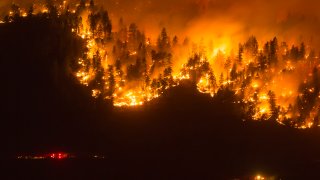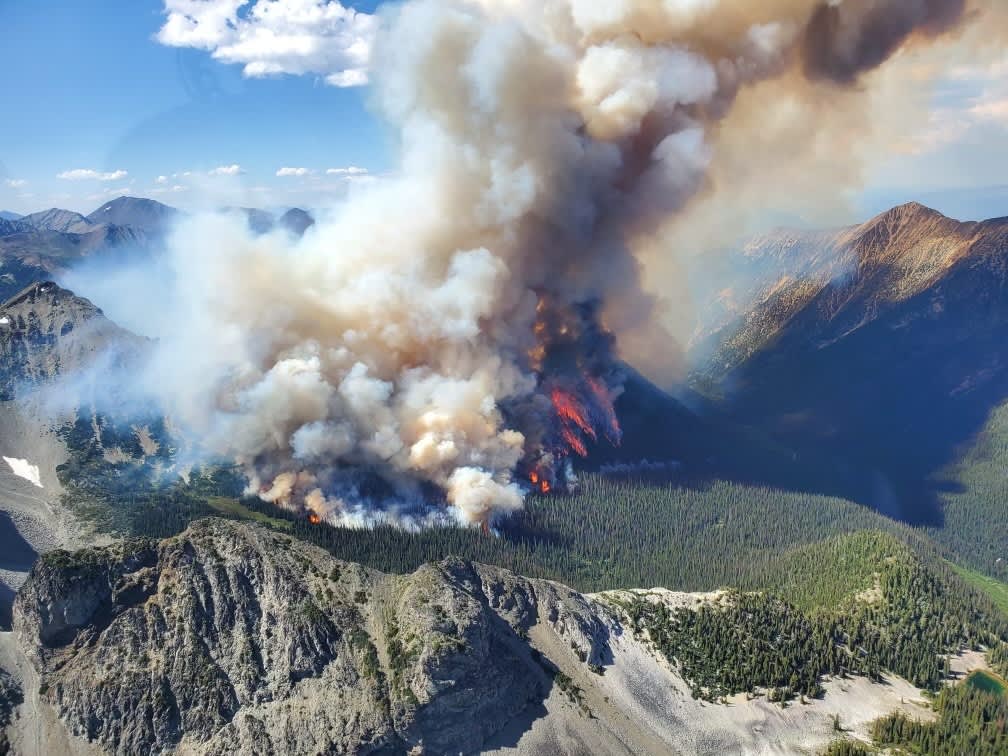
Thousands of residents fled the capital of Canada's Northwest Territories ahead of an approaching wildfire Thursday, some driving hundreds of miles to safety and others waiting in long lines for emergency flights, the latest chapter in Canada's worst fire season on record.
The fire, boosted by strong northern winds, was within 16 kilometers (10 miles) of Yellowknife's northern edge, and people in the four areas at highest risk were told to leave as soon as possible, Fire Information Officer Mike Westwick said.
Officials worried that winds could push the flames toward the only highway leading away from the fire as long caravans of cars evacuated the city of 20,000, and although some rain was forecast, first responders were taking no chances. Westwick urged residents in other areas to leave by noon Friday.
“I want to be clear that the city is not in immediate danger and there’s a safe window for residents to leave the city by road and by air,” Shane Thompson, a government minister for the Territories, told a news conference. “Without rain, it is possible it will reach the city outskirts by the weekend.”
Feeling out of the loop? We'll catch you up on the Chicago news you need to know. Sign up for the weekly Chicago Catch-Up newsletter here.
Evacuating such a large number of people is “going to be tough,” but people were cooperating and staying calm, Westwick said.
Canada has seen a record number of wildfires this year — contributing to choking smoke in parts of the U.S. — with more than 5,700 fires burning more than 137,000 square kilometers (53,000 square miles) from one end of Canada to the other, according to the Canadian Interagency Forest Fire Centre. As of Thursday, 1,053 wildfires were burning across the country, more than half of them out of control.
In the Northwest Territories alone, 268 wildfires have already burned more than 21,000 square kilometers (8,100 square miles).
Thursday's evacuation of Yellowknife was by far the largest so far this year, said Ken McMullen, president of the Canadian Association of Fire Chiefs and fire chief in Red Deer, Alberta.
“It's one of those events where you need to get people out sooner rather than later,” because fire could block the only escape route before ever reaching the community.
Resident Angela Canning was packing up her camper with important documents, family keepsakes and basic necessities and leaving with her two dogs, while her husband stayed behind as an essential worker.
“I’m really anxious and I’m scared. I’m emotional... I'm in shock,” she told The Canadian Press. “I don’t know what I’m coming home to or if I’m coming home. There’s just so much unknowns here.”
At the Big River Service Station about 300 kilometers (185 miles) south of Yellowknife, the line of vehicles waiting for fuel was “phenomenal,” employee Linda Croft said. “You can't see the end of it.”
About 6,800 people in eight other communities in the territory have already been forced to evacuate their homes, including the small community of Enterprise, which was largely destroyed. Officials said everyone made it out alive.
A woman whose family evacuated the town of Hay River on Sunday told the CBC that their car began to melt as they drove through embers, the front window cracked and the vehicle began filling with smoke that made it difficult to see the road ahead.
“I was obviously scared the tire was going to break, our car was going to catch on fire and then it went from just embers to full smoke,” said Lisa Mundy, who was traveling with her husband and their 6-year-old and 18-month-old children. She said they called 911 after they drove into the ditch a couple of times.
She said her son kept saying: “I don’t want to die, mommy.”
Prime Minister Justin Trudeau was convening an urgent meeting with ministers and senior officials Thursday to discuss the evacuation.
Authorities said the intensive care unit at a Yellowknife hospital would close within 24 hours as the Northwest Territories health authority starts to reduce its services. In-patient units from Stanton Territorial Hospital would be moved in the coming days, if required, and most long-term care patients were transferred to institutions to the south, the Health and Social Services Authority said on its website.
Officials said evacuations have so far been safe and orderly, and that evacuees from Yellowknife who can’t find their own accommodations can get support in three centers in the province of Alberta. The closest of those centers is more than 1,000 kilometers (620 miles) by road from Yellowknife.
Officials in Calgary said they're preparing to take in thousands of evacuees, and are opening a reception center at the Calgary airport, where five evacuation flights were expected to arrive Thursday. A second center has been set up at a hotel for those who drive to the city, said Iain Bushell, the city’s director of emergency management.
Only those who cannot leave by road should register for the evacuation flights, officials added. People who are immunocompromised or have conditions that put them at higher risk also were encouraged to sign up.
"We’re all tired of the word unprecedented, yet there is no other way to describe this situation in the Northwest Territories," Premier Caroline Cochrane posted on X, formerly known as Twitter. She urged residents to obey emergency management officials, traffic control devices and posted speed limits.
The evacuation order issued Wednesday night applies to the city of Yellowknife and the neighboring First Nations communities of Ndilo and Dettah.
Indigenous communities have been hit hard by the wildfires, which threaten important cultural activities such as hunting, fishing and gathering native plants.
Amy Cardinal Christianson, an Indigenous fire specialist with Parks Canada, has said the wildfires “are so dangerous and so fast-moving” that evacuations increasingly are necessary, which is a challenge in remote communities where there might be one road in, or no roads at all.
Officials in British Columbia, where about 370 fires were burning, also braced for more evacuations, with the weather forecast for the next few days predicting dry lightning that could spark new blazes and brisk winds that could change direction quickly.
Cliff Chapman, director of provincial operations at the province's Wildfire Service, urged anyone at risk to pack a “grab-and-go” bag and to respect any evacuation orders.
The U.S. has also seen devastating wildfires, including fires last week on the Hawaiian island of Maui that killed more than 100 people and destroyed a historic town.
Rural areas near California’s border with Oregon were placed under evacuation orders Wednesday after gusty winds from a thunderstorm sent a lightning-sparked wildfire racing through national forest lands, authorities said.



